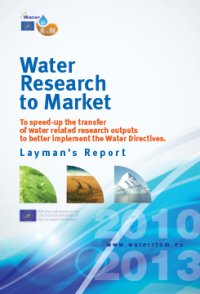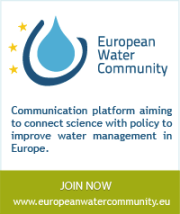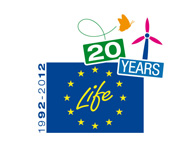AGRICOLNAM
| Output characterisation | |
| OUTPUT SENTENCE | Ways of exploitation of biodegradable waste sludges (from the river basins and the wastewater treatment plants) |
| OUTPUT TYPE | methodology |
| WATER TOPIC | Quality of natural systems |
| KEYWORDS | Quality of natural systems, Sludge Management. |
| KEYWORDS TYPE | methodology, procedure. |
| MARKET NEED TAILORED | The project concerns the reuse of waste from municipal wastewater and residue accumulated in the beds of those lakes. The services provided by the project refer to the development of experimental models by which the water quality policy and waste management is supported. |
| OUTPUT DESCRIPTION | The objective was to identify by analysis and research of biodegradable waste recovery methods such as residue reservoirs (storage pools) and sludge from urban wastewater treatment plants. The end result of the project had two main directions: exploitation in agriculture of residue sludge from the ponds / lakes and / or urban wastewater treatment plants and / or energy recovery in biogas plants. Through the 3 stages of the research were obtained: • 1 model of recovery type of waste sludge from sewage plants and waste from storage pools by using as a substrate for biological material such as fruit trees, corn and lettuce; • 1 way analysis of greenhouse gas emissions from biodegradable waste in order to establish an energy recovery solution. • 3 working procedures for the determination of physico-chemical characteristics and removal of biodegradable waste. • 1 documentation containing input data to perform a database of different types of biodegradable waste (sludge from wastewater treatment plants, waste from storage tanks, etc.). |
| STATE OF DEVELOPMENT | Pilot at small scale |
| INNOVATIVE ASPECTS AND ADVANTAGES | The realization of complex research papers to determine the mechanism of crossing toxic compounds present in biodegradable waste (sludge from sewage plants and the storage tanks) in fruit and vegetables. The use of advanced characterization techniques (molecular and atomic absorption spectrometry, gas-chromatography, mass spectrometry) to:
|
| INTELLECTUAL/INDUSTRIAL PROPERTY RIGHTS | IPR belongs to the partners. Intellectual property on technical documentation, on technical and scientific results, patents etc. lies with the coordinating contractor and partners. |
| TRANSFERABILITY | Until today the use of technology as a substrate of the 2 types of waste was tested only one of the partners (SCDP Valcea). It can also be used in crops with potential energy (biomass). |
| POTENTIAL USERS/CLIENTS |
|
| Estimation of risks | |
| EVALUATION OF RISKS FOR OUTPUT USERS | Currently, the sludges from municipal wastewater treatment plants are not used and the drained waste from the reservoirs are deposited in the immediate vicinity thereof, without identifying a potential use them. The results obtained by these types of waste reuse involves identifying potential users located in close proximity to these sources of waste (see section anticipated customers). |
| ECONOMICAL RISKS | ? ? |
| TECHNICAL RISKS | Technical risks are caused by soil types (soil tested low in nutrients) of sludges (heavy metals in traced amounts, but with a high capacity of storage and stabilization), by the types of plants (shrubs with certain periods of growth). |
| MARKET RISKS | There has been a reluctance manifested by land users in using this type of mud. |
| Steps ahead | |
| NEXT STEPS TO ACHIEVE THE STATUS 'READY TO USE' |
|
| TYPE OF PARTNER FOR THE NEXT DEVELOPMENTS | • Administration of basins and wastewater treatment plants, waste management operators, SMEs dealing with waste management. |
| TASKS TO BE PERFORMED | Technical assistance on soil and plant characteristics to be tested with the produced fertilizers. Achieving in partnership of a guide for fertilizer users. Industrial-scale testing of the 2 types of waste as substrates (fertilizers) for agricultural soils except those for grazing, cultivation of fruit trees, vegetables, fruit shrubs by 10 months before harvest and during harvest (according to Order 344 / 2004). |
| COLLABORATION DETAILS | Technical cooperation, agreement of financing. |
| Estimation of ressources | |
| RESOURCES FOR NEXT STEPS | Preparation of a sole suitable for the cultivation of plants in this technology. 5 researchers - 10 days / month |
| FORESEEN COSTS FOR NEXT STEPS | Costs for testing - 50,000 Lei (11 000 euro) Technology improvement costs - 40,000 Lei (9 000 euro) |
| Contact | |
| TECHNICAL CONTACT | Ecaterina Matei |
| COUNTRY | ROMANIA |
| WEBSITE | www.ecomet.pub.ro |
| WATER RTOM CONTACT | CFPPDA |
| Background | |
| PROJECT NAME | Ways of exploitation of biodegradable waste sludges (from the river basins and the wastewater treatment plants) to reduce pollution |
| PROJECT ACRONYM | AGRICOLNAM |
| PROJECT DESCRIPTION | The objective was to identify by analysis and research of biodegradable waste recovery methods such as residue reservoirs (storage pools) and sludge from urban wastewater treatment plants. ?The objective was to identify by analysis and research of biodegradable waste recovery methods such as residue reservoirs (storage pools) and sludge from urban wastewater treatment plants. The end result of the project had two main directions: exploitation in agriculture of residue sludge from the ponds / lakes and / or urban wastewater treatment plants and / or energy recovery in biogas plants. Through the 3 stages of the research were obtained: • 1 model of recovery type of waste sludge from sewage plants and waste from storage pools by using as a substrate for biological material such as fruit trees, corn and lettuce; • 1 way analysis of greenhouse gas emissions from biodegradable waste in order to establish an energy recovery solution. • 3 working procedures for the determination of physico-chemical characteristics and removal of biodegradable waste. ?• 1 documentation containing input data to perform a database of different types of biodegradable waste (sludge from wastewater treatment plants, waste from storage tanks, etc.).? |
| LEADER | Politehnica University of Bucharest - Science and Material Engineering Faculty - Center for Research |
| TEAMS INVOLVED | "Politehnica" University of Bucharest - Science and Material Engineering Faculty - Center for Research and Eco - Metallurgical Expertise - ECOMET - The University of Agricultural Sciences and Veterinary Medicine of Cluj-Napoca - Research and Development Station for Pomiculture (fruit growing) Valcea- SC ICPE Bistrita SA - OSKAR VON MILLER - CONCEPTION, RESEARCH AND DESIGN INSTITUTE FOR THERMAL POWER EQUIPMENT |
| COUNTRIES INVOLVED | ROMANIA |
| PROJECT LOCATION | RO |
| FUNDING ORGANISATION | CNMP |




